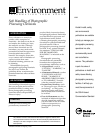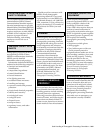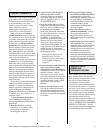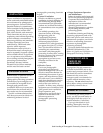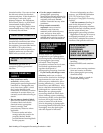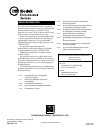
Safe Handling of Photographic Processing Chemicals • J-98A 5
chemical residue. Use water to rinse
the skin area where the chemical
contact took place. If the chemical is
a developer, wash with a pH-
balanced cleanser, like Phisoderm,
Sulfo Hand Cleaner, or pH6. Wash
contaminated clothing before
wearing it again. Thoroughly clean
contaminated shoes; if they can not
be cleaned, discard them.
Immediately identify which
chemical was swallowed and follow
the first-aid recommendations on
the container/processor label and in
the MSDS. Call a physician or
poison-control center as quickly as
possible; make sure you have the
MSDS with you when you call.
Immediately get fresh air. If
symptoms persists, get medical
attention.
• Keep containers easily
accessible—Always store
photographic processing chemical
containers in a designated area,
away from heavy traffic, where
they can be identified and
inventoried, if necessary. Position
containers in an area where you
can easily reach without having to
stretch.
• Do not remove chemical labels
that come on chemical containers.
Container labels include the
chemical name, appropriate
hazard warnings, and
precautionary measures where
applicable.
– Processor tanks and other
storage tanks also need to be
properly labeled. Kodak
provides hazard warning labels
for this purpose.
SWALLOWED CHEMICALS
INHALED VAPORS AND
GASES
STORE CHEMICALS
SAFELY
• Use the proper containers—
photographic processing
chemicals should only be stored in
the containers in which they were
originally delivered. Do not
transfer chemicals into any other
containers.
• Keep corrosive materials
separated—store corrosive
materials away from any
materials with which they may
react, and away from other
incompatible materials. See the
stability and reactivity section on
the MSDS for more information.
Always follow the procedures
designated for your photographic
processing facility when disposing
of photographic processing
chemicals. These disposal
procedures are based on local, state,
and federal requirements that
regulate the disposal of
photographic processing chemicals.
If your facility discharges waste
solutions, make sure you have
reviewed the local sewer discharge
requirements for your area. use
silver-recovery methods for silver-
bearing effluents (e.g., used fixers,
bleach-fixes, and stabilizers). Also,
know what other materials may be
discharged to a common drain.
Never pour any photographic
processing chemicals into a drain
where cleaning agents containing
chlorine are present, unless the drain
has been thoroughly rinsed. Run
plenty of water down the drain,
prior to disposing of photographic
processing chemical effluents, then
thoroughly rinse the drain again
after the disposal of effluents.
PROPERLY DISPOSE OF
PHOTOGRAPHIC
PROCESSING
CHEMICALS
For more information on silver
recovery, see KODAK Publication
J-212, The Technology of Silver
Recovery for Photographic Processing
Facilities.
If off-site treatment (hauling) is
used for the disposal of waste
photographic processing solutions,
make sure the only solutions poured
into the waste drum(s) are
photographic processing solutions.
Regardless of the type of recovery
or disposal procedure you use in
your facility, maintain the system so
overflows and spills do not occur.
• Know the chemicals you are
handling.
• Read the MSDSs and container
labels.
• Use care when moving containers
from one location to another.
• Store photographic processing
chemicals safely.
• Do not eat, drink, or smoke in
chemical handling areas.
SAFE HANDLING OF
PHOTOGRAPHIC
PROCESSING
CHEMICALS IS EASY
WHEN YOU USE COMMON
SENSE AND WHEN YOU:



